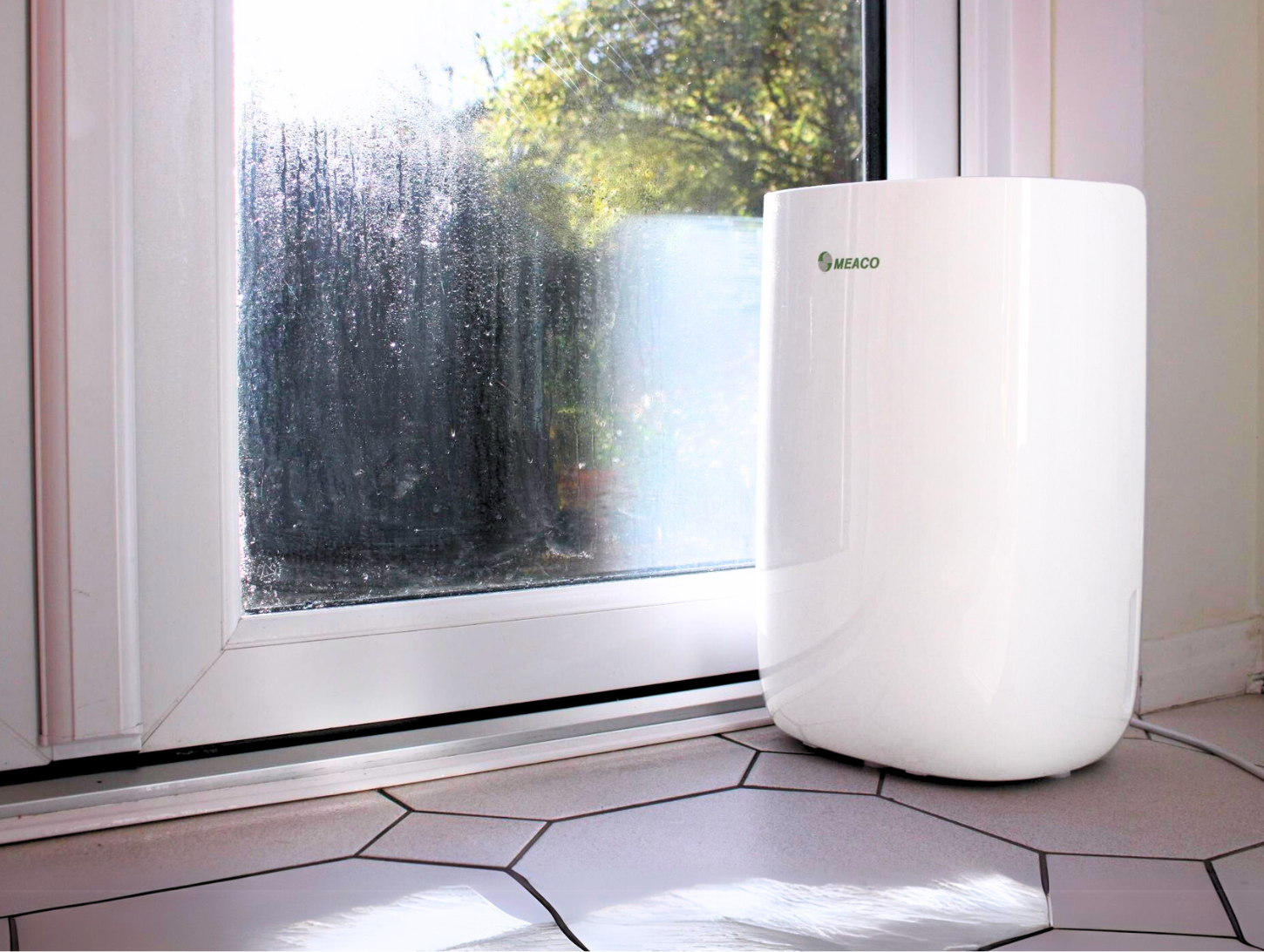
With the cold, there’s also condensation. When the temperature drops outside, generally below 5°C overnight, you’ll start seeing condensation on your windows. You may notice this most in the bedroom, kitchen, bathroom or conservatory, especially early in the morning. Stopping condensation is one of the biggest problems homeowners face.
So, how can you stop condensation? The two main approaches to ‘curing’ or ‘stopping’ condensation are either to open the windows or use a dehumidifier. Open the windows may give pretty instant results but we’re letting in the cold air and then paying to heat it back up. Dehumidifiers provide a fast, effective and cost-efficient way to manage condensation.
Opening windows to deal with condensation
You would probably expect me to recommend that you buy a dehumidifier. I am a dehumidifier manufacturer after all. But let’s look at the benefits of opening windows first.
In Germany, they call it “Stoßlüften”, meaning “shock ventilation” and they may have the right idea about things… When people worry about condensation or mould problems, the advice will often be to open the window. This is to improve ventilation.
However, in some older properties that are often quite ‘leaky’, we can see that condensation is rarely an issue. I mean that in properties with older windows, we don’t always see more condensation. These windows might let in some moisture and may not be fully draft-proof. However, condensation is about trapped moisture inside the house, not extra moisture coming in.
Opening windows can cure condensation – but do you want to let the cold in?
So why does ventilation help? Opening windows can stop condensation – but do you want to let the cold in?
First, what causes condensation on windows?
Essentially, condensation occurs when air meets a cold surface and forms water on that surface. And it’s all about the relationship between relative humidity and temperature. In most cases, the surface is the cold glass panes of your windows and the relative humidity is moisture within your home. It doesn’t matter how little moisture there is in the air – if the surface is cold enough, you will get condensation.
Your windows provide the perfect cold surface because they are in direct contact with the chilly outside. If you touch the window pane, you’ll feel the difference!
This is why my windows at home have been free of condensation for months. Now the temperature has dropped, I can suddenly see condensation. I doubt that the amount of moisture in the air in my home has increased. It is just that the surface temperature of the window is lower during a cold spell.
This is also why you’ll find double-glazed windows usually have less condensation than single-glazed ones. This is because the two panes form an insulated barrier. And as a result, the inside pane isn’t quite as cold and condensation is less likely to occur. Remember that double-glazing condensation can still happen, it’s just less frequent than single glazing. This does not mean your windows are broken but there are steps you can take to reduce it.
What is the science behind condensation: the relationship between humidity and temperature?
Condensation forming on cold surfaces happens because of the inverse relationship between temperature and relative humidity. As temperature falls, relative humidity increases and as temperatures increase, relative humidity falls. So if you heat air up, the relative humidity will decrease. This is the key to the reason why ventilation can help cure condensation.
So, there are two things helping to form condensation, the temperature of a cold surface (your windows) and relative humidity. Of these, which can we control in order to stop condensation?
Unless you have fancy heated windows, then the answer is relative humidity. You can do this in a few ways. Let’s start with opening the window.
Does opening the window stop condensation?
Ultimately, yes. You’ll quickly notice the condensation leaving the windows. The air in your home is full of moisture from cooking, bathing, showering, drying washing and even breathing. The air outside in winter will probably have a lower relative humidity. So when you open the windows, warm, damp air goes out and cold air comes in.
Condensation can build up easily on any cold surface, especially windows throughout winter.
But now your room is a lot colder and you don’t know whether the outside air has changed your room’s relative humidity.
Have we helped to reduce the condensation situation? The answer is still yes. If you’re having a hot shower and open the window a smidge, you can watch the condensation reduce dramatically.
It is also because we are not going to let the air stay cold. We will heat it up to a temperature that we are comfortable with.
Even if the air outside is freezing, I still want it to be about 20°C in my house but I’ve opened the window and let some of that cold air in. I will warm it up and I’ll turn the heating on.
And in the laws of science, increased temperature means decreased relative humidity. If we assume the incoming air is full of moisture, warming it up will reduce that relative humidity as well. Let’s say the incoming air has a relative humidity around 90%rh, increasing the temperature will reduce it down to something like 25%rh.
So, all is good! We have got rid of our warm damp air, replaced it with cold damp air and warmed it up. We now have warm dry air. There’s a cure for condensation.
Opening the windows will work and is an effective solution to condensation control.
But..
Think about what we have just done. We have heated the air, costing us money, and then we have thrown that heated air out of the window. It might have been easier to throw fivers into the street!
To replace it, we have introduced freezing cold air into our home and made ourselves feel very uncomfortable.
Now, we need to warm the cold air. This will help us feel comfortable again and lower the humidity. This costs more money in energy, and later in the day, we’ll have to do it all over again. In fact, ideally you will have to do this in every room in the house. You will certainly need to do it in the bathroom, kitchen and bedrooms at the very least.
Opening the windows does work but I am not a fan because of two reasons. One, it makes people feel uncomfortable. Secondly, there’s a huge hidden cost of reheating the fresh air coming in from outside. With energy bills skyrocketing it seems a real waste of money to keep on throwing the energy outside.
Is a dehumidifier a better way to stop or prevent condensation?
Yes, a dehumidifier is a superb way to manage relative humidity in your home and reduce condensation. Plus, a dehumidifier is the only way you’ll remove moisture. As we mentioned earlier: condensation occurs because of temperature and relative humidity. You are unlikely to control the temperature of your windows, but you can manage relative humidity with a dehumidifier. Making a dehumidifier an incredibly effective choice to prevent condensation.
Running a dehumidifier does of course have a cost to it. There is an initial price of the unit, and then there’s the electricity cost to run it.
But there is an important difference between the cost of running a dehumidifier and the cost of heating air.
MeacoDry ABC Dehumidifier extracting excess moisture and preventing condensation from occurring
- Some dehumidifiers create a little warmth while dehumidifying. Desiccant dehumidifiers create around 12°C which is ideal especially in garages and conservatories.
- If you’re opening the window and running the central heating, you’re potentially throwing hundreds of pounds away every year. The hot air often escapes through the window. You will just heat it up again later when you open another window.
- Finally, heating dry air is actually a lot cheaper than heating damp air. Read more: 7 Ways to Stay Warm, Save Money, and Delay Turning the Central Heating On
We use our dehumidifiers mainly in the winter when condensation is at its worst. It’s freezing outside which provides the perfect cold surface on your windows to condensate. And we are closing the windows and doors, trapping moisture in our home. This is the perfect recipe for condensation.
In the winter, it is cold and we need to heat our homes. The energy used by the dehumidifier is returned to the room that it is standing. And that energy is in the form of warmer air.
So the cost of running a dehumidifier is retained within your home. If you have a radiator within the same space as the dehumidifier, you can turn it off – helping to keep your energy bills down. So where is the cost of running the dehumidifier if you are benefiting from and enjoying the heat that it generates?
Read more: How much does it cost to run dehumidifier units? Less than you think!
How do deal with condensation in a conservatory
Condensation in conservatories is a hugely common problem for homeowners. It’s a room of windows, creating that perfect cold surface. It’s unheated so we’re not reducing the relative humidity by increasing temperature. And it’s just as likely as the rest of the house to contain moisture.
Both solutions work well for reducing condensation in these spaces: opening windows and running a dehumidifier. But if you want to proactively prevent condensation in a conservatory? My best recommendation is to manage your relative humidity with a desiccant dehumidifier.
Read more: How do I prevent condensation in a conservatory?
A dehumidifier is a fast, effective and cost-efficient way to stop condensation. Opening the windows may seem to be the easy – and free – solution, but it’s not quite as cheap as it looks!
We recommend…
- Compact and stylish dehumidifier
- Quiet Mark – from just 36dB
- Eliminates moisture – ideal for damp, mould and condensation
- Shop now
Meaco Low Energy Dehumidifiers
- Low cost to run – 4p / hour based on 24.50p / kWh
- Quiet Mark Award – up to 41 dB
- Tackles damp, mould and condensation
- Shop now
Meaco DD8L Desiccant Dehumidifier
- Superb at removing condensation from windows
- Desiccant dehumidifier
- Provides additional warmth & offers high performance
- Shop now
Browse all dehumidifiers.

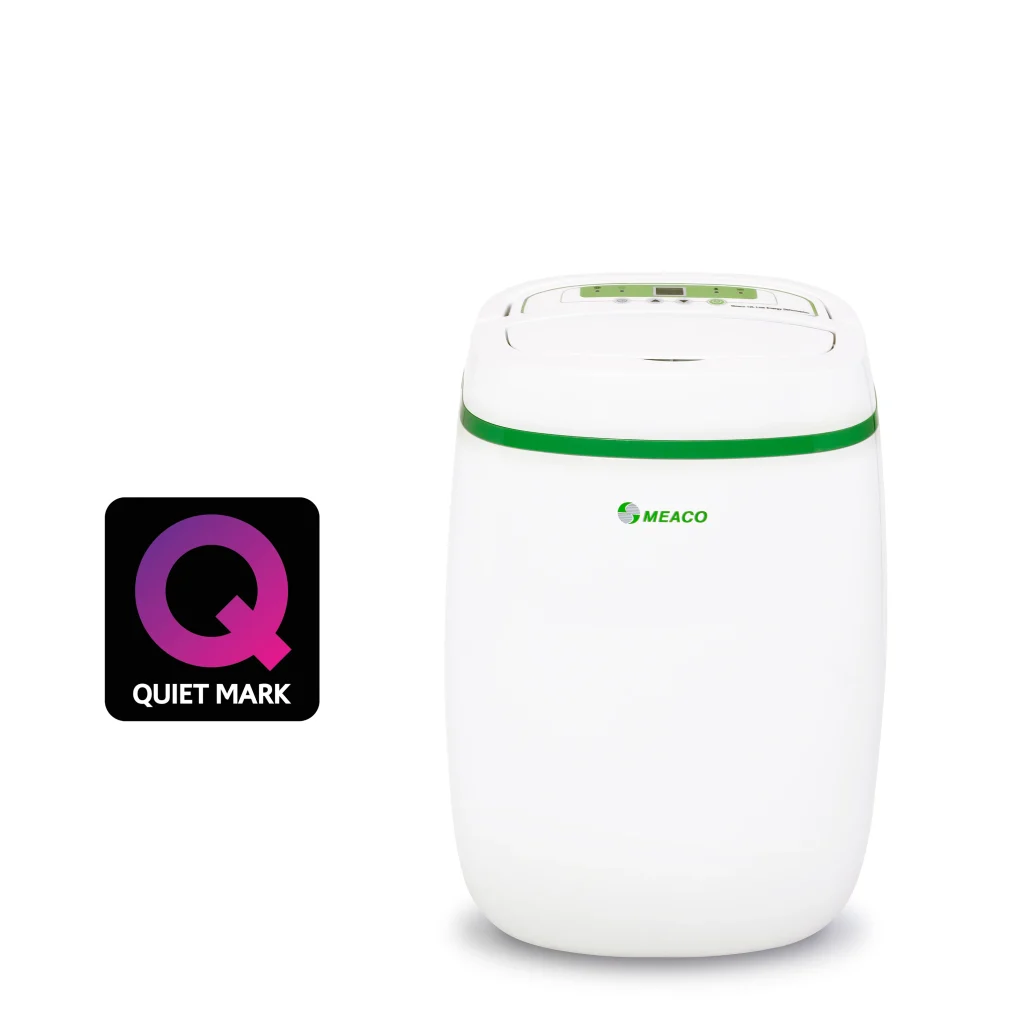
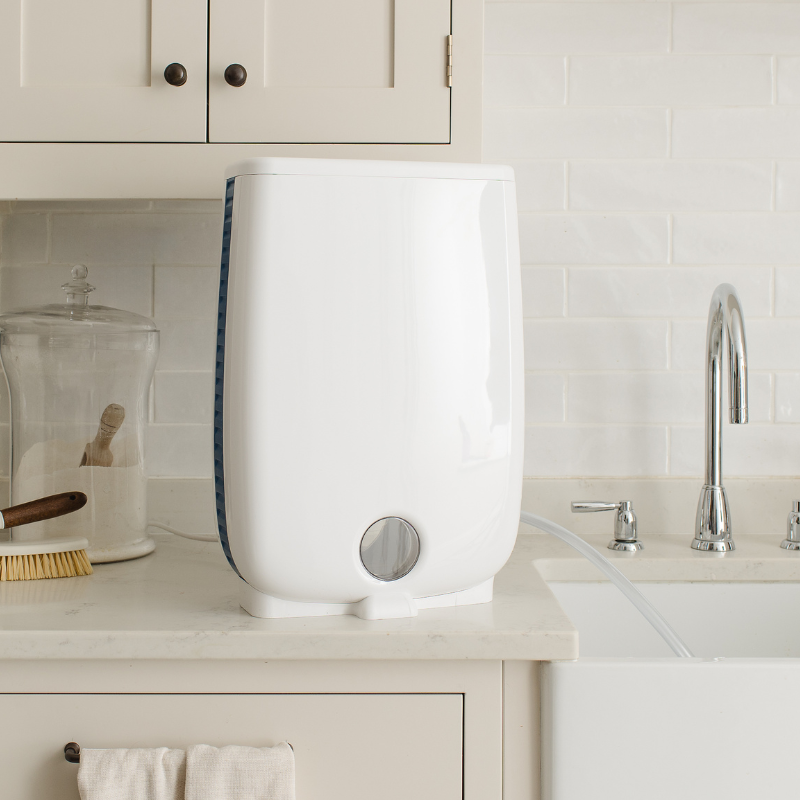





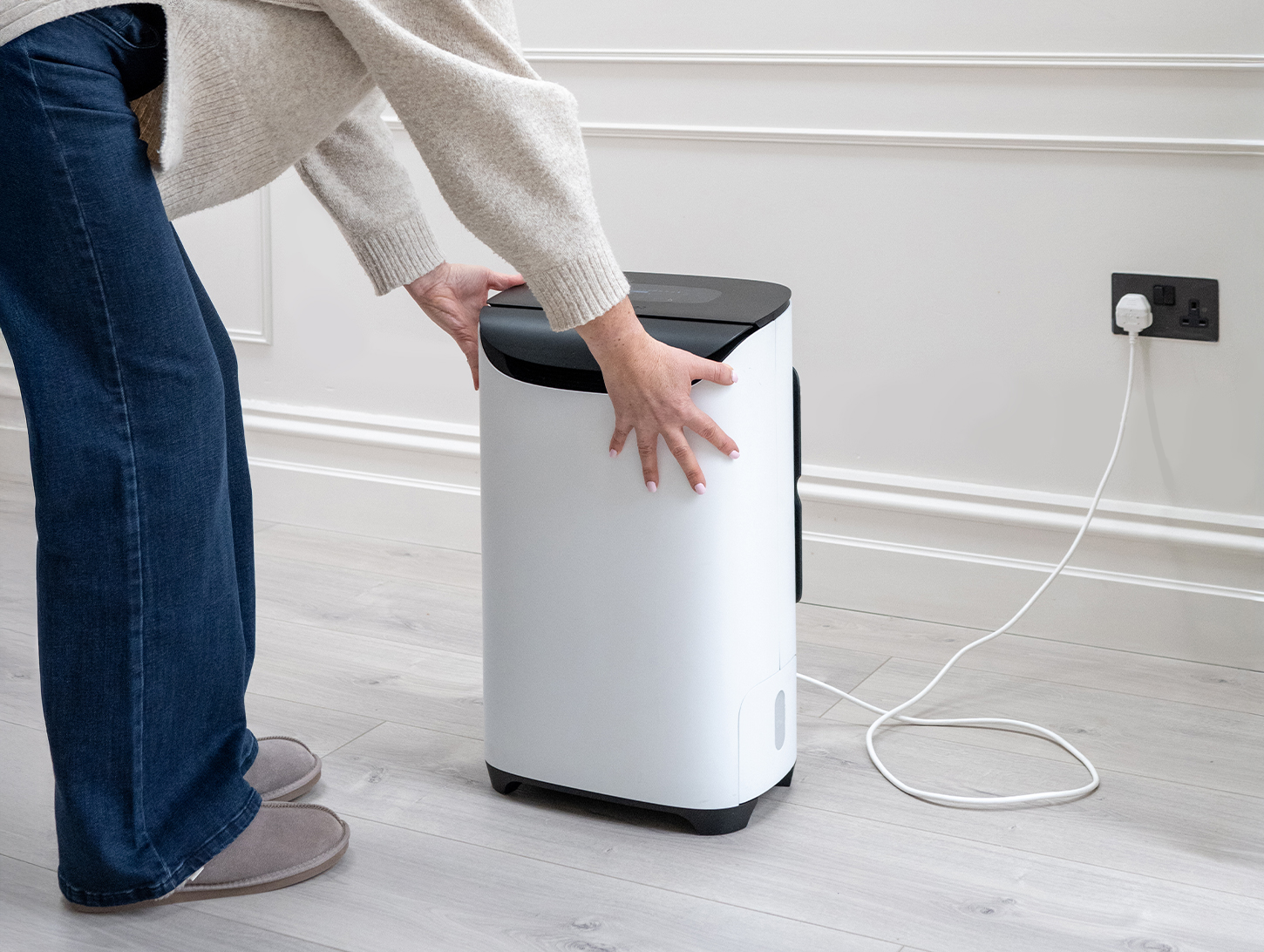
215 responses
Hi Chris,
thank you for all your useful comments on this page. I wonder whether I could also ask you for some advice.
I live in a Georgian Townhouse with a vaulted basement (mostly bricks / stones), but some areas of the basement only have a wooden ceiling to the rooms above. These are only small areas, but from the basement the wooden planks from the rooms above can be seen. The temperature in the basement is relatively constant throughout the year. Unfortunately, there is hardly any natural ventilation in the basement. As soon as temperatures go up in the spring, a musty smell develops in the ground floor level of the house, and in particular in the two rooms above the basement, where there are the areas with just the wooden floor in between. The musty smell is much less of an issue in winter. There is no area of dampness in the basement. I therefore think that the musty smell is due to condensation between the basement and the ground floor and favours mould and/or dry rot. I would like to install a dehumidifier, but I’m not sure whether this needs to go into the ground floor or into the basement. What would your advice be?
Thank you for your help.
Ann
Ann,
A common problem. The dehumidifier needs to go into the basement and your application is explained here – https://www.meaco.com/blog/the-best-dehumidifier-for-a-basement/
Chris
Question: Why do we not have a device yet, or do we? that combines a dehumidifier, a heater/air conditioner, and water distiller all in one unit. This compact space saving unit could solve moisture problems and provide clean potable, drinkable water as well as heat or cool the air. And if the dehumidifier used copper instead if aluminum to prevent water contamination the distiller part may not even be needed.
Troy,
You can buy an air conditioner that heats and dries as an all in one already. The water is a different issue because there will be metal containements and dirt in the water.. water that comes out of a dehumidifier is not actually distilled.
Chris
Hi Chris,
Thanks for all the help so far, you are a hero!
I’m hoping you can help me solve my problem. I have just moved into a house share and my room (large size with 1 bay window then side window) has issues with condensation, it is also carpeted which I don’t think helps. The inside of the windows have water build up despite the recent heat and I am getting the typical breathing issues that comes from mold/condensation. I was told it would be fixed but now it is not looking likely so am stuck. I have bought a moisture absorber but that seems to do very little. I was wondering what your best solution would be on a really low budget? Thanks and I hope you can help with this stressful problem
Sam,
Sorry to hear about your problems. To have condensation at this time of year on windows makes no sense really because the air temperatures are in the high 20s/low 30s the surface temperature of the windows are also very high. For it to be a condensation issue you would need a very high room temperature and almost 100% humidity within the room. Are you getting puddles of water on the windowsill or are you able to wipe water off the glass?
Are you doing anything in the room to produce humidity (drying loads of clothes, lots of showers with no extractor fan, running a humidifier?) or is there a leak coming from above the window?
At this time of year you can get rid of the excess humidity by just opening the windows but you would want to understand the source of the water before winter arrives.
Let me know what happens.
Chris
Hi Chris,
Thanks for getting back to me so quickly. I am doing nothing in the room to produce moisture. There aren’t puddles either, the water seems to be inside the panes of glass. my sinuses are really bad while in the house, especially my room. The house doesn’t seem to have mold anywhere so I am really confused as to why this is happening. The moisture absorber I bought has collected a lot of water overnight. Do you think a dehumidifier would help? or maybe an air purifier
Sam,
That makes more sense now. You do not have a condensation issue, the double glazing is ‘blown’. Take this information to your landlord and if they do not help have a search for blown double glazing online but it is something that you should not touch without the owners permission.
But it is not a dehumidifier issue.
Chris
Hi Chris!
I was wondering: I live in Scotland, in a relatively dry area. My house is old and especially one of the bedrooms is very damp (rising damp or condensation, I’m not sure). It gets moldy. I’ve used a dehumidifier since a few years which helps but only if it’s on all day every day.
I have a few questions:
With warmer weather I’ve tried a few times leaving the window open for a while, to let the rom air, but it seems to make the moldy smell worse? I don’t understand why? Is it more humid outside than in?
Also, is using a dehumidifier the best thing to do in such a damp room? It seems to slowly get more musty and the carpet is starting to smell moldy!
Rosalie,
Thank you for your message and I am sorry to hear of your issues. I would think about a couple of things;
First – where is the water coming from? If the bedroom is on the first floor then it is not rising damp, if it is a bungalow then maybe. But try and think where the water is coming from (how do you dry your washing, do you have and use extractor fans, are gutters blocked, any leaks anywhere, are there cracks in the external brickwork etc).
Secondly – warm summer air does how a lot of humidity in Britain and mould will often grow faster in the summer. In the winter opening a window can work because the air coming in is cold and is then warmed up (and therefore dried) by the central heating. This would explain why your musty smell increases in the summer.
I would think about where the water is coming from and then try to reduce it. After that stick with the dehumidifier and let it run 24/7 to really get on top of things.
Hope this helps.
Chris
Hi Chris! I’m just confused of using dehumidifier during winter. Others say that we could only use it during summer and other say we need it as well during winter especially when a part of the house smell like a damp rug. We lived in Winnipeg where the weather drops to -48 to -53. One of our windows right now is completely frozen. We bought a 30 pint dehumidifier yesterday and I think we breath more comfortably. Can we use the dehumidifier in one part of the house and humidifier near in our bedroom? Im so confused with these 2 units.
Recelle,
Absolutely, do what is right for you and not what others say is good for them. it would probably be a good idea to get a humidity meter and see what readings you have, try and maintain 40 – 60%rh throughout for the best compromise.
regards
Chris
Hi Chris, I have purchased a Meaco 12L (to reduce humidity in my 1 bed flat and hopefully deal with some mould on ceiling, walls). When you say leave it on for 24 hours (in some of your advice above ) when you first buy it to dry out a flat – do you mean on the energy saving setting? or on constant setting for 24 hours? I switched it on when I first bought it (on the energy saving setting) and it reached the 55% humidity level quickly so should I just leave it on this setting to ‘do its thing’? or do i switch on constant setting for 24 hrs? Thanks for your time.
Michael,
Thank you for your purchase. 55%rh is fine for a flat and you should only drop down to say 50%rh if you find that the flat could benefit from being dryer. When you first receive a dehumidifier you can run it on constant for say the first week to give the entire space a good drying out or you can use the humidistat as you are to dry more slowly and steadily. You will end up in the ame space in the long run.
regards
Chris
Hi, I have recently brought a dehumidifier as we get a lot of condensation on our windows. Mould is also becoming a problem in one of our 3 bedrooms. What is the best way to use the dehumidifier to stop this? In our bedroom we get condensation dripping from the ceiling above the window also. Should i have it on constantly or just place in each room until condensation is gone? Any advice would be great. Many thanks.
Steve,
Sounds like you have serious issues there so keep the dehumidifier running all of the rime and aim for a constant 50%rh in the house. Put the dehumidifier somewhere central in the home and leave the internals doors open when it is running. the damp air will migrate naturally towards the dehumidifier.
If you can reduce the amount of moisture in the air by using extractor fans in the kitchen/bathroom and/or opening windows for 15 minutes after cooking/bathing.
Hope this helps.
regards
Chris
Hi Chris
Thank you for your website and your tips above. I’m looking for your thoughts though please. I live in a 2 story, 3 bedroom townhouse. I don’t have a laundry/utility room and not space for a tumble drier (that’s in the shed at the bottom of the garden). I know that I am in need for a dehumidifier as my children have become more conscientious of personal hygiene (which I’m not complaining about) which in turn is leading to a worsened condensation problem and mould/mildew particularly in the bathroom. So I was wondering if you would recommend having 2 dehumidifiers – 1 for keeping the house in general dry by keeping it on the landing and 1 for drying clothes or would just the 1 suffice?
Thanks
Denise
Denise,
Sounds like the children are getting towards the teenage years! One dehumidifier would be fine, I would go for the 25L Low Energy because it dries washing really fast, has a great Quiet Mode and uses very little energy.
Hope this helps.
Chris
Hi Chris
I’ve read through with a lot of interest but can’t find a similar problem to mine.
I have a detached bungalow built around 1990. New double glazed windows, no trickle vents.
The condensation on the windows is not too bad but in every room bar one I have a big condensation problem.
Each window/door has a reveal and so a little into the room (where the cavity would effectively end) where the ceiling and window call meet I have a thick width of water droplets on the ceiling.
The roof has a lot of insulation but from what I can see doesn’t go right to the edge so I think there is a ‘cold bridge’ as there are a lot of vents on the soffits (17 each side of the building and each approx 6 x 3 inch).
I have a dehumidifier but as I keep opening the windows and putting the heating on maybe it’s not being too effective but I welcome your thoughts.
Also, would it be worth blocking up some vents as they do seem a bit excessive and pulling the insulation further over?
I was looking at a PIV system for the loft as an alternative.
Am at my wits end really!!
Thanks in advance for any assistance you can offer.
Lisa,
Thank you for your question. Don’t block up vents because they serve an important purpose. You are right in thinking that you might have a cold bridge but I would look and think how can you get yourself to a situation where you have less moisture in the air, the dehumidifier is doing its job but what else can you do? Do you have extractors in the bathroom and kitchen? Do they work and do you use them enough. Do you cook with lids on pans, do you use the dehumidifier to dry your washing if you dry laundry indoors.
Actually opening windows and having heating on is actually what a PIV system is and is an effective way of drying the air. Opening windows to let moisture out after bathing or cooking is a perfectly good idea.
Hope this helps.
regards
Chris
We live in a 3 bedroomed 1930s semi detached house with condensation problems in the cold weather bible cropping up. What kind/size dehumidifier should we get? How long do we run it for? And where can we put it so it gets the entire house?
I also already have one in a closed room where I dry the laundry. It’s the Pro Breeze 1500ml but windows in that room still are getting very steamed up when it gets very cold outside even with windows open and be dehumidifier on collecting water as normal.
Carolina,
Thanks for your message. In fairness to the ProBreeze it is far too small for such a job. You need a proper dehumidifier, a 20L low Energy model would be fine. Just put it somewhere central in the home and leave all the internal doors open and you will notice a massive difference.
regards
Chris